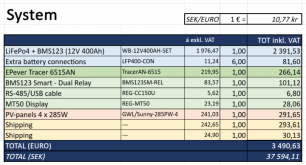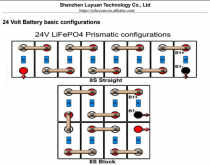Background info
Last year, just before Covid struck the entire world, my better half and I bought an off-grid summer house. It’s a property of about 15 acers, in the middle of the deep Swedish forests. We spent most of our spare time last year at the cabin – safe to say it’s our favorite spot in the world. Our long-term plan with the property is to make it a year around place.
The cabin has an existing solar power system, 12V, 300W PV-array, built in 1995. The previous owner used some ordinary sealed lead acid batteries (about 220 Ah in total) and during the autumn those stopped taking charge.
We’ve researched and looked at different options and has decided to replace the batteries with a LiFePO4 battery, new charger and PV-array. As our long-term plan is to be there a lot more, we wanted to build a bigger system but keep the initial investment low, because there are a lot of other projects that needs doing as well.
We have calculated that our consumption is at most about 1.8 kWh per day for lightning, fans (no AC of course), pumps, 4G router and WIFI, charging phones and computers. We run both stove, water heater and refrigerator on gas.
The system
The battery is a 12V 400Ah LiFeYPO4 battery set we intend to buy from GWL, with an included 123Smart BMS. The battery gives us 4.8 kWh of storage. If I’ve done the calculations right, we can go two days without any charging and still be within 80% DoD. A regular day well below 50% DoD. The SMART BMS is included and feels like a safe option for us with a smart relay that will turn of either charging or load as a last resort if the safety system of the charge controller fails. (Link: https://shop.gwl.eu/Winston-12V-set...-400Ah-cells-BMS-mobile-monitoring.html?cur=1)
The charge controller is a EPever Triron-AN 6515AN. A 60A solar controller, with a max open voltage of 150V (138V), capable of handling battery voltages from 12-48V. With battery deep discharge protection, overcharge protection, overvoltage protection and relay output to control loads. (Link: https://www.epsolarpv.com/product/44.html)
The solar array have 4 x 280W panels (Voc 38,2, Isc 9.45) in a two string of 2 panels configuration. The house and walls/roof where the current solar panels are mounted is not in the direct south but rather one wall/roof is in south-east and one to south-west. Therefore, we split the panels into two string and place one sting on either wall/roof. The two strings won't be in direct sunlight at the same time, but we maximize how much sun hits the panels over one day - and keep the array close to the house and charge controller. (Link: https://shop.gwl.eu/Solar-PV-System...y-285Wp-60-cells-ESP285-Pack-4-pcs.html?cur=1)
Surge protection (lightning arrestor), as the property is located on a hill and thunder storms are quite common we’ve also added two pair of lightning arrestors, between the charge controller and PV-array as well as the battery and rest of the system. I’ve not found as much information about this as I would have wanted but have taken some inspiration from prebuilt systems available in Sweden and found these lightning arrestors that have the same specifications. (Link: https://www.amazon.se/gp/product/B08HMXGB12/ref=ppx_yo_dt_b_asin_title_o01_s00?ie=UTF8&psc=1 and https://www.amazon.se/gp/product/B08R3F1RQX/ref=ppx_yo_dt_b_asin_title_o00_s00?ie=UTF8&psc=1
Extending the system in 2-3 years
In 2 or 3 years we want to extend the system to a 24V 400Ah battery by adding four more battery cells, additional cell modules for the 123Smart BMS and adding an inverter to get 230V.
Budget
We have calculated a budget for the complete system of about 4000 € as we replace an existing system we’re only going to replace some of the cabling from the panels to the charge controller as well as between the battery, charge controller and fusebox.

System diagram

Last year, just before Covid struck the entire world, my better half and I bought an off-grid summer house. It’s a property of about 15 acers, in the middle of the deep Swedish forests. We spent most of our spare time last year at the cabin – safe to say it’s our favorite spot in the world. Our long-term plan with the property is to make it a year around place.
The cabin has an existing solar power system, 12V, 300W PV-array, built in 1995. The previous owner used some ordinary sealed lead acid batteries (about 220 Ah in total) and during the autumn those stopped taking charge.
We’ve researched and looked at different options and has decided to replace the batteries with a LiFePO4 battery, new charger and PV-array. As our long-term plan is to be there a lot more, we wanted to build a bigger system but keep the initial investment low, because there are a lot of other projects that needs doing as well.
We have calculated that our consumption is at most about 1.8 kWh per day for lightning, fans (no AC of course), pumps, 4G router and WIFI, charging phones and computers. We run both stove, water heater and refrigerator on gas.
The system
The battery is a 12V 400Ah LiFeYPO4 battery set we intend to buy from GWL, with an included 123Smart BMS. The battery gives us 4.8 kWh of storage. If I’ve done the calculations right, we can go two days without any charging and still be within 80% DoD. A regular day well below 50% DoD. The SMART BMS is included and feels like a safe option for us with a smart relay that will turn of either charging or load as a last resort if the safety system of the charge controller fails. (Link: https://shop.gwl.eu/Winston-12V-set...-400Ah-cells-BMS-mobile-monitoring.html?cur=1)
The charge controller is a EPever Triron-AN 6515AN. A 60A solar controller, with a max open voltage of 150V (138V), capable of handling battery voltages from 12-48V. With battery deep discharge protection, overcharge protection, overvoltage protection and relay output to control loads. (Link: https://www.epsolarpv.com/product/44.html)
The solar array have 4 x 280W panels (Voc 38,2, Isc 9.45) in a two string of 2 panels configuration. The house and walls/roof where the current solar panels are mounted is not in the direct south but rather one wall/roof is in south-east and one to south-west. Therefore, we split the panels into two string and place one sting on either wall/roof. The two strings won't be in direct sunlight at the same time, but we maximize how much sun hits the panels over one day - and keep the array close to the house and charge controller. (Link: https://shop.gwl.eu/Solar-PV-System...y-285Wp-60-cells-ESP285-Pack-4-pcs.html?cur=1)
Surge protection (lightning arrestor), as the property is located on a hill and thunder storms are quite common we’ve also added two pair of lightning arrestors, between the charge controller and PV-array as well as the battery and rest of the system. I’ve not found as much information about this as I would have wanted but have taken some inspiration from prebuilt systems available in Sweden and found these lightning arrestors that have the same specifications. (Link: https://www.amazon.se/gp/product/B08HMXGB12/ref=ppx_yo_dt_b_asin_title_o01_s00?ie=UTF8&psc=1 and https://www.amazon.se/gp/product/B08R3F1RQX/ref=ppx_yo_dt_b_asin_title_o00_s00?ie=UTF8&psc=1
Extending the system in 2-3 years
In 2 or 3 years we want to extend the system to a 24V 400Ah battery by adding four more battery cells, additional cell modules for the 123Smart BMS and adding an inverter to get 230V.
Budget
We have calculated a budget for the complete system of about 4000 € as we replace an existing system we’re only going to replace some of the cabling from the panels to the charge controller as well as between the battery, charge controller and fusebox.

System diagram






